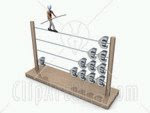 With the markets having matched the lows made in 1996, and the S&P; 500 closing below the 700 level a couple of days ago, the question remains where the next support, which may provide a temporary bottom, is.
With the markets having matched the lows made in 1996, and the S&P; 500 closing below the 700 level a couple of days ago, the question remains where the next support, which may provide a temporary bottom, is.
In times like this, it pays to look at technical support and resistance levels for the various indexes. Let’s focus only on the widely followed S&P; 500 and review what MarketWatch had to say in “Further losses likely before the next major low:”
After concluding its worst six-month span since 1932, the Dow Jones Industrial Average has broken into the 6,000s to start March.
This places the blue-chip benchmark and the S&P; 500 at less than half their record highs established 17 months ago, and based on the current backdrop, further losses are likely before a sustained upturn.
…
Beginning with the S&P; 500, its hourly chart details the past three weeks (see chart in article).
With this week’s downturn, the index has broken decisively under the November low of 741, notching its worst close since October 1996.
From current levels, first resistance holds at 729 — matching the bottom of Monday’s gap — and is followed by more significant overhead around 741.
…
Meanwhile, the S&P;’s 10-year view is even uglier.
In its case, the S&P; closed Monday on the 700 mark representing a nearly 10% break below the 2002 low. (Again, this chart doesn’t include the March price action).
Looking ahead, the index faces major resistance spanning from 741 to 768, bracketing the November low and the 2002 trough.
Conversely, notable downside targets fall out as follows:
1. S&P; support around 680. The May, June and July 1996 peaks each fell within five points of this level.
2. S&P; support at 600. The January 1996 low held at 597, and the July 1996 low came in at 605.
Based on the current backdrop, an eventual retest of the S&P; 680 area looks increasingly likely.
There you have it. What this simply means is this. If a rally materializes, expect it to run into resistance at the 729 level; if that gets pierced, then watch out for the 741 level.
On the downside, support may kick in at around 680 and, if that is taken out, we may be looking at 600, which many forecasters have called to be the ultimate bottom.





